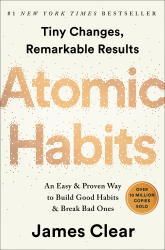# Introduction
An atomic habit is a regular practice or routine that is small, easy to do and rewarding.
Bad habits repeat themselves because you have the wrong system for change, not because you don’t want to change.
Instead of setting goals, focus on your identity and the underlying systems that support your definition of self.
# Habits vs. Goals
Success is the culmination of good habits, not rare life-changing transformations. Focus on the trajectory, not the current results. Outcomes are lagging measures:
- your weight eight vs eating habits
- your net worth vs financial habits
- your knowledge vs learning habits
Breakthrough moments are the cumulative result of many previous actions, building up until they reach some sort of critical mass.
Potential is not recognized as a linear function, but a step-based plateau, with flat (or even declining) progression until you "level up".
Goals: win the game
System: Continue playing the game
Behaviour incongruent with the self will not last.
Actions need to be compatible with our base system of beliefs and values to drive the changing behaviour that supports adoption of desired processes.

Frame ideas and actions as character defining, otherwise we pursue end goals, which are win/lose, momentary and polarize success and failure.
Goal often don’t persist long enough to change behaviour.
We solution from the inside out, and results come from processes that support our identity.
"Outcomes are about what you get. Processes are about what you do. Identity is about what you believe."
- Decide what we want to be
- Prove it with repeated, small wins
# Build Better Habits
A habit is a behaviour repeated enough times to become automatic. It has four components:
| Component | Key |
|---|---|
| CUE | Make it OBVIOUS |
| CRAVING | Make it ATTRACTIVE |
| RESPONSE | Make it EASY |
| REWARD | Make it SATISFYING |
The opposite is also true; we can break bad habits by making them INVISIBLE, UNATTRACTIVE, HARD and UNSATISFYING.
# Obvious
- We want triggers that are obvious and unambiguous: expectations are stated.
- Automatic behaviour is error prone.
- Point & calling => raises awareness.
- Use implementation intentions: "I will [BEHAVIOUR] at [TIME] in [LOCATION]"
- Stacking – tie desired behaviour into something we already do: "After [CURRENT HABIT], I will [NEW HABIT]"
- Use the environment to repeat cues.
- The opposite applies to bad habits: we want to make them invisible, unattractive, difficult and unsatisfying.
- Once a habit is formed it is unlikely to be forgotten.
- To eliminate a bad habit reduce exposure to the cues that cause it.
# Attractive
- It’s the anticipation not fulfillment that is rewarding.
- Behaviors that deliver approval, respect and praise are attractive.
- We need to design actions that result in these AND be vigilant in reinforcing them.
- Invert to make bad habits unattractive. Highlight the benefits of avoiding a bad habit.
- Association with negative feelings makes something unattractive.
- Do something you enjoy immediately before a difficult to break bad habit.
# Easy
"The best is the enemy of the good" - Voltaire
- New behaviours need to be quick (< 2 minutes).
- Humans will pursue a least effort prioritization.
- Reduce friction of good behaviours.
- Technology that automates behaviours makes bad ones invisible and guarantees the right ones.
- Establish a habit, then improve a habit; standardize before you optimize.
- Some choices are one-time, single actions that automate future habits: ex: automatic savings plan, buying a good mattress.
# Satisfying
- Immediate reward > delayed reward
- Behaviour that is immediately rewarded will be repeated.
- Behaviour that is immediately punished is avoided.
- Goodhart’s Law: "When a measure becomes a target, it ceases to be a good measure."
- Need to make progress; habit tracking (like calendars and lists) help mark progress.
- Keep streaks alive
- Don't miss twice
- Focus on tasks right near the edge (but not beyond) current abilities.
- The greatest threat to success is not failure but boredom.
- The upside of habits is that we can do things without thinking. The downside is that we stop paying attention to little errors.
- Habits + Deliberate Practice = Mastery
- Reflection and review is a process that allows you to remain conscious of your performance over time.
